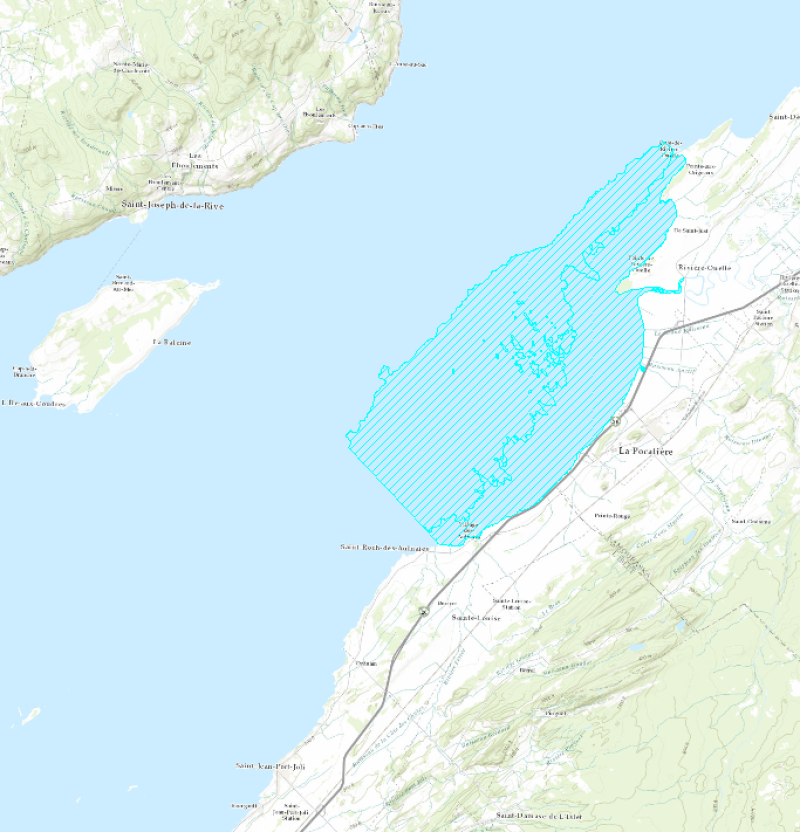Morone saxatilis
Type of resources
Topics
Keywords
Contact for the resource
Provided by
Formats
Representation types
Update frequencies
status
-

PURPOSE: These data have been updated following a Canadian Science Advice Secretariat (CSAS) Regional Science Advisory Process. Associated publications are available in the citation section below or will be posted on the Fisheries and Oceans Canada (DFO) Science Advisory Schedule as they become available. Estimate the abundance of Striped bass spawners in the Northwest Miramichi estuary. DESCRIPTION: Spawner abundance estimates of Striped Bass in the Northwest Miramichi estuary based on Catch per unit effort (CPUE) analysis in the commercial gaspereau fishery. USE LIMITATION: To ensure scientific integrity and appropriate use of the data, we would encourage you to contact the data custodian.
-

Striped Bass critical habitat (St. Lawrence estuary population) defined by the analysis of available knowledge in 2011 and a scientific advice. Purpose The status of the Striped Bass population of the St. Lawrence Estuary is in constant evolution. It went from indigenous population until the end of 1960 to designated extirpated in Canada under the Species at Risk Act (SARA) in 2011. Still in 2011, the status of the population of the St. Lawrence Estuary was reassessed by the Committee on the Status of Endangered Wildlife in Canada (COSEWIC) following the Ministère des Ressources naturelles et de la Faune du Québec re-introduction efforts and was designated endangered (COSEWIC 2012). Under SARA, critical habitat must be designated for all threatened, endangered or extirpated species. Additional Information The analysis of available knowledge on habitat quality assessment and its use by the Striped Bass was realized using two research documents: Pelletier et al. (2010) and Robitaille (2010). These documents were then reviewed during a scientific peer review meeting in April 2010. A Recovery Strategy was also established in 2011. Pelletier, A.-M., G. Verrault, G. Bourget and J. Dussureault. 2010. Utilisation de l’habitat par les différents stades de développement de la population réintroduite de bars rayés (Morone saxatilis) de l’estuaire du Saint-Laurent. Ministère des Ressources naturelles et de la Faune du Québec, Direction de l’Expertise Faune-Forêt-Territoire du Bas-Saint-Laurent. 50 p. Robitaille, J. 2010. Assessment of Habitat Quality and Habitat Use by the Extirped Striped Bass Population (Morone saxatilis) of St. Lawrence Estuary, Quebec DFO Canadian Science Advisory Secretariat. Research Document. 2010/052. 22 p. DFO. 2011. Assessment of Habitat Quality and Habitat Use by the Striped Bass (Morone saxatilis) Population of the St. Lawrence Estuary, Quebec. DFO Can. Sci. Advis. Sec. Sci. Advis. Rep. 2010/069. DFO. 2011. Robitaille, J., M. Bérubé, A. Gosselin, M. Baril, J. Beauchamp, J. Boucher, S. Dionne, M. Legault, Y. Mailhot, B. Ouellet, P. Sirois, S. Tremblay G. Trencia, G. Verreault and D. Villeneuve. 2011. Recovery Strategy for the Striped Bass (Morone saxatilis), St. Lawrence Estuary Population, Canada. Species at Risk Act Recovery Strategy Series. Ottawa : Fisheries and Oceans Canada. xi + 51 p. The available information on habitat used and frequented by the St. Lawrence Estuary striped bass population has been reviewed later than 2011 and can be consulted at: https://open.canada.ca/data/en/dataset/db177a8c-5d7d-49eb-8290-31e6a45d786c
-

Each summer, environmental community groups collect important data to determine if groupings of fish, shrimp and crab – what is called a community- can be used as an indicator of the health status of bays and estuaries. Sampling was conducted from May through September for the first years then from June through August. In 2018 and 2019, the sampling was conducted just once in each estuary. Community group members and staff sample six stations once a month in their designated estuary. Fish, shrimps and crabs are collected with a beach seine net and later released live back to the water once identified and counted. From this, the community groups provide important information to Fisheries and Oceans Canada, including: - identification and numbers of fish, shrimp and crab species; - water conditions and samples; - information on aquatic plants; - sediment samples. With this information, Fisheries and Oceans Canada scientists working with government agencies and universities can conduct analyses to determine the suitability of indicators to assess the health of bays and estuaries. PARAMETERS COLLECTED: Parameters: abundance, species richness, species developmental stage (young-of-the-year or adult), water temperature, water salinity, water dissolved oxygen, dissolved inorganic nutrient (nitrate, nitrite, phosphate), sediment % organic content, sediment % humidity content and sediment mean grain size, % submerged aquatic vegetation cover NOTES ON QUALITY CONTROL: Data entry into Excel and first quality control verification is done by CAMP summer students. A second quality control verification is done by DFO staff. See publ # 2823 attached to this record. In 2018, the historical data was migrated into a relationship database. From this year on, annual data will be entered into the database using a custom application. The application front end has numerous QC elements built-in. SAMPLING METHODS: Please see the following URL for sampling details: http://www.dfo-mpo.gc.ca/Library/319437.pdf
 Arctic SDI catalogue
Arctic SDI catalogue